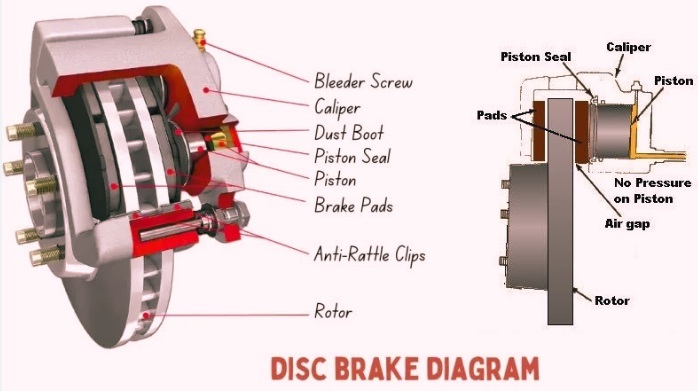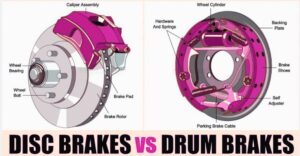Brakes are a main part of each car that helps stop car during driving and avoid any collision. car and other automobile industries are working on making innovations and new ideas for brakes. The two commonly used brake types are drum and disc brakes. In this post, we will cover detailed features for these two braking systems and find their applications with differences.
What are disc brakes?
- Disc brakes were made at a time when drum brakes were common, but at that time technology was not advanced, and their high cost did not make them common.
- First disc brake used car, that known as the Crosley Hot Shot, but it not operate well so not used.
- In 1953, Jaguar used disc brakes for a racing car for a racing event and won the race, so everyone was shocked by this racing feature.
- Disc brakes on the Jaguar car also crossed the working of cars that have drum brakes, and it won on its debut.
- After that, disc brakes became commonly used for a larger number of cars.
- The disc brake comes with a disc, caliper housing, brake pads, and a piston. If the brake pedal is pushed, hydraulics apply force on the piston for pushing the brake pad on one side, and a reverse piston is used for pulling the brake pad on the other side of the rotor.
- in a resulting squeezing motion that applies high force on the disc and stops the vehicle.
What is a drum brake?
- Drum brakes were first made in 1902 by Louis Renault. That was the first parking system for cars. Drum brakes come with important parts like a drum connected with a wheel, brake shoes in the drum, and a cylinder connected with the brake pedal.
- If pressure is applied on the brake pedal, the main cylinder applies force on the brake shoes to connect with the inner part for rotating the drum, producing friction and halting the wheel from rotating.
- Drum brakes come with different features that make them useful for making cars and are normally used for the back tires of cars.
- Drum brakes come with a drum and a brake shoe. The drum is a cylinder-shaped bowl that moves with wheel rotation.
- In the drum, there are brake shoes that expand when the brake pedal is pressed and apply pressure to the internal surface of the drum to produce friction and stop the vehicle.
How do drum brakes work?
- Drum brakes come with 5 main components for working: hydraulic wheel cylinder, return spring, backing plate, curved brake shoes, and brake drum.
- When we apply force on the brake pedal, brake fluid is pushed into the hydraulic system that operates the piston in the wheel cylinders.
- It causes motion of curved brake shoes in the outer direction and connection with the drum.
- Friction produced when shoes collide with a rotating brake drum transforms kinetic energy into thermal energy and stops the car.
- When pressure on the brake pedal reduces, the return spring in the brake drum separates the shoe from the connection point.
- Drum brakes come with high stopping features as compared to disc brakes, but are affected by overheating.
- It minimizes the efficiency of braking materials and also distorts the brake drum.
- It also makes brake fluids overheat, which causes brake fading.
- The drum braking system also comes with moving components that require high maintenance.
disc brakes working
- The disc braking system comes with a rotating disc caliper and brake pads. When we apply force on the brake pedal, pistons in the brake caliper push the pad against the rotor, convert kinetic energy into thermal energy, and stop the car.
- The disc brake is simple and effective to operate. larger size of brake disc, effective to deal with and dissipate heat produced during braking, and control brake fade and overheating.
- The brake has less chance for slipping in extreme conditions.
- This system has a low working cost and normally little experience. A mechanic can replace these brakes, also one at home
- But the manufacturing of a disc braking system can be more costly than a drum braking system.
- Either it is efficient, but there are high costs in terms of brake pad and brake disc replacement as compared to drum brake parts.
Drum Brake vs Disc Brake
| Feature | Drum Brakes |
Disc Brakes
|
| Stopping Power | It has low stopping power for high speeds |
It has good stopping featurs for high speeds
|
| Heat Dissipation | It has bad heat dissipation and is affected due to high heat |
got heat dissipation, minimizes brake fade
|
| Cost | low cost for maintenance. |
high cost of manufacturing and maintaining
|
| Maintenance | Simpler |
complex maintenance
|
| Durability | long-lasting |
faces warping or needing replacement
|
| Use | used on the back wheels of city cars |
Front wheels and high-performance cars
|
Advantages of Drum Brakes
- Drum brakes are easier to make and lower cost to replace than disc brakes, so they make a low-cost option for vehicles.
- The design and assembly of drum brakes is simple since it has fewer parts, which makes its installation easy.
- Some drum systems come with self-adjusting features that provide constant working with simple adjustment.
- Drum brakes are effective for stopping with low speeds, so they are the best option in high traffic and stop-and-go driving.
- It ensures that it protects different brake components from dust, water, and other materials for increasing working life
- Drum brakes provide smooth braking features that are good for comfortable driving.
Advantages of Disc Brakes
- Disc brakes dissipate heat effectively as compared to drum brakes, minimize the chances of brake fading, and provide constant braking for heavy use.
- Its design is such that it provides easy airflow over braking parts, provides fast cooling, and avoids heating during longer use of the braking.
- Disc braking has high power working and response for stoppage for a short time, and works safely for different conditions.
- Sinc has good heat dissipation, disc brakes have low brake fading, and they work well in difficult conditions.
- Disc brakes need less maintenance than drum brakes.
Disadvantages of Drum Brakes
- Drum brakes cause overheating when brakes are used continuously or when moving downhill, or when applying high-speed braking. For cooling, it does not have an outlet. That makes brake shoes glaze and affect braking.
- When a hard brake is applied, the drum expands due to thermal expansion. So pressing the brake pedal farther.
- Due to moisture and rust conditions, the brake shoe causes grabbing for the drum brake. that needed more braking than usual. Due to the grab, the tires skid and continue until the pedal is released. That loses car control and is not good for driving when you are at high speed
- Its different components make repairing difficult.
Disadvantages of Disc Brakes
- Disc brakes are high-cost, and these brakes are used on the back wheels.
- For speed braking, it can prevent rotor warping. It occurs due to high temperatures on discs, and improper installation of disc brakes also causes warping.
- brake pads on discs. Brakes cause wear faster than drum brakes; that is due to the squeezing movement of the brake piston on the brake pads. It provides a stoppage but affects the brake pad.
FAQs
What is a disc brake?
- The disc brake is a braking system that uses a metallic disc connected to the wheel. Calipers squeeze brake pads over a disc that causes friction to stop the car.
Why are disc brakes mostly used?
- Disc brakes are good to use since they have good stopping power, dissipate heat well, and have constant performance.
How do disc brakes work?
- The main function of disc brakes is to stop cars through transforming kinetic energy into heat through friction and provide easy control through proper steering features.
Disc brake or ABS: which one is better?
- Disc brakes and anti-lock braking systems are used for different purposes since one is a mechanical braking part and the other is an electronic system that controls wheel locking at the time of hard braking. Both operate with each other for control and safety purposes.
How much does it cost to replace disc brakes?
- The replacement cost for disc brakes for cars is about 300 to 1000 dollars but can be higher based on the vehicle. Prices included components and labor costs. The replacement cost is based on the manufacturer and vehicle model.
Why are disc brakes used?
- Disc brakes have been used since they have higher speed working and better safety factors than drum brakes, which provide high speed and difficult braking conditions.
What are the limitations of disc brakes?
- The main drawbacks of disc brakes are high cost, difficult maintenance, and warping in high-heat conditions.


